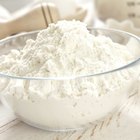
Whenever possible, you should mix cake batter with an electric mixer, because mixing cakes by hand can make them more dense. If you do not have access to a mixer, you can take steps to ensure your cake ends up as light as possible. Understanding and keeping in mind the basic function of the ingredients and the preparation steps will help you bake a delicious cake, whether by hand or with a mixer.
Don't Skip the Sift
Though you may be tempted to skip sifting the dry ingredients together before mixing your cake, this step is crucial in creating a light and fluffy cake. Sifting the flour, baking soda or powder, salt and any other dry ingredients removes lumps and blends the ingredients evenly. This allows you to blend the batter more evenly and more quickly.
Add Enough Air
Whether you are following a recipe that uses the creamed method, in which you cream fat and sugar together, or the foamed method, in which you fold beaten eggs into the batter, you are adding air cells to your batter. This incorporation of small pockets of air helps to leaven the cake batter and develop the structure and crumb of the cake. Make sure you cream the fat and sugar or beat the eggs thoroughly before mixing with the other ingredients for a light and fluffy cake.
Minimize Mixing
Your mantra when preparing batter by hand should be: do not over-mix. Stirring and beating the batter develops gluten -- strands of protein that will make the cake chewy and dense. Once you have developed the air cells, whether through creaming or foaming, and are adding the remaining ingredients, mix only enough to incorporate the ingredients. As soon as the batter comes together, stop mixing.
Cold Ingredients Can Ruin Cakes
Bring all of your ingredients to room temperature before mixing your cake, including the eggs. When any of the components of the cake batter are too cold, they may cause the batter to separate. If this happens and you bake the batter, the crumb will be dense and uneven. Butter should be room temperature before creaming, not melted, unless your recipe calls for it.
Add in Order
Follow your recipe's order for mixing the ingredients. Generally, liquids should be added in increments. This ensures full incorporation of the dry ingredients and helps achieve even batter. Alternate between adding the sifted dry ingredients and your liquid, beginning and ending with the dry components. Again, make sure to mix only until everything is incorporated with each addition.
Related Articles

How Long Do You Have to Mix the Flour ...

How to Add Gluten to All-Purpose Flour

Does Adding an Extra Egg to Brownie Mix ...

What Causes Cupcakes to Fall?

What Kind of Oil Do You Use in Brownie ...

How to Use Millet Flour
Can Dry Pudding Be Added to Cake Mixes?
Should Cake Flour Be Sifted Before ...

How to Make Whipped Frosting Without ...
Can You Make a Pie Shell Using Pancake ...

Will Adding Cocoa Powder to a Cake Dry ...

Hand Kneading vs. Stand Mixer

How to Substitute Oleo for Cooking Oil ...
How Do I Make the Cake Lighter When I'm ...

What Causes Cheesecakes to Sink in the ...

How to Make a Two-Layered Birthday Cake ...

How to Bake a Cake Without Egg Whites

The Ingredients of Neutrogena Sensitive ...

Do Eggs Make Baked Goods Rise?
What Do Bakeries Use in Their Whipped ...
References
- Baking and Pastry: Mastering the Art and Craft; The Culinary Institute of America
- On Food and Cooking: The Science and Lore of the Kitchen; Harold McGee
- The Art and Soul of Baking; Sur La Table
Resources
Writer Bio
Kathryn Roberts has worked in the culinary industry for nearly a decade in various roles, including pastry chef and bakery manager. After studying at the Culinary Institute of America, she earned her BFA from Goddard College and is pursing an MFA in Writing from Vermont College of Fine Arts.
Photo Credits
Jupiterimages/Polka Dot/Getty Images